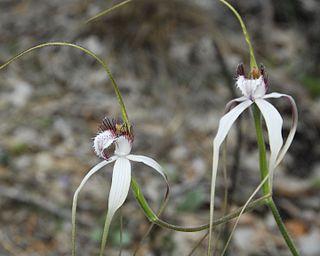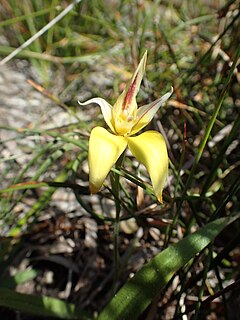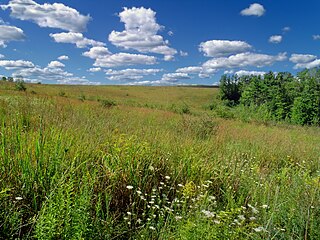
Caladenia longicauda is a species of plant in the orchid family Orchidaceae and is endemic to the south-west of Western Australia. It is distinguished by its large leaf and by its up to five large, white flowers which have drooping sepals and petals with long, thickish brown "tails".

Caladenia bicalliata subsp. bicalliata, commonly known as the limestone spider orchid or dwarf limestone spider orchid, is a plant in the orchid family Orchidaceae and is native to the south-west of Western Australia and coastal areas of South Australia. It has a single erect, hairy leaf and one or two cream-coloured flowers with reddish-brown tips.
Caladenia bicalliata subsp. cleistogama, commonly known as the shy limestone spider orchid or sandhill spider orchid, is a plant in the orchid family Orchidaceae and is native to the south-west of Western Australia. It has a single erect, hairy leaf and one or two cream-coloured flowers which are smaller than those in subspecies bacalliata.
Caladenia bryceana subsp. bryceana, commonly known as the dwarf spider orchid, is a plant in the orchid family Orchidaceae and is endemic to the south-west of Western Australia. It has a single spreading, hairy leaf and a single green to apricot-coloured flower. It is a small orchid and difficult to find, even when quite abundant in a particular location. It is found in the far south-west corner of the state, unlike subspecies cracens which grows near Kalbarri.
Caladenia bryceana subsp. cracens, commonly known as the northern dwarf spider orchid, is a plant in the orchid family Orchidaceae and is endemic to the south-west of Western Australia. It has a single spreading, hairy leaf and a single green to apricot-coloured flower. It is a small orchid and difficult to find, even when quite abundant in a particular location. It has a more northerly distribution than subspecies bryceana which grows closer to Albany.
Caladenia corynephora, commonly known as the club-lipped spider orchid, is a plant in the orchid family Orchidaceae and is endemic to the south-west of Western Australia. It has a single erect, hairy leaf and one or two greenish-yellow and red flowers which have a labellum with a club-like tip. It is the only Western Australian caladenia with a clubbed labellum.

Caladenia denticulata subsp. denticulata, commonly known as the yellow spider orchid, is a plant in the orchid family Orchidaceae and is endemic to the south-west of Western Australia. It has a single erect, hairy leaf and one or two yellowish flowers which have a white labellum with pale red markings.
Caladenia denticulata subsp. albicans, commonly known as the alabaster spider orchid, is a plant in the orchid family Orchidaceae and is endemic to the south-west of Western Australia. It has a single erect, hairy leaf and one or two pale creamy-white flowers which have a white labellum with red markings. The only known population occurs in a small area near Arrowsmith.
Caladenia denticulata subsp. rubella, commonly known as the clumped spider orchid, is a plant in the orchid family Orchidaceae and is endemic to the south-west of Western Australia. It has a single erect, hairy leaf and one or two dull or pinkish red flowers with prominent dull red markings and with a white labellum with red markings.

Caladenia flava subsp. sylvestris, commonly known as the karri cowslip orchid, is a species of orchid endemic to the south-west of Western Australia. It has a single, hairy leaf and up to three pale yellow and cream-coloured flowers which are white near the tips of the sepals and petals and marked with bright red or pink.

Caladenia longicauda subsp. crassa, commonly known as the Esperance white spider orchid, is a plant in the orchid family Orchidaceae and is endemic to the south-west of Western Australia. It has a single hairy leaf and up to three mostly white flowers with long, broad, spreading lateral sepals and petals, a relatively broad labellum with short, narrow teeth. It grows on the south coast between Bremer Bay and the Cape Arid National Park.

Caladenia longicauda subsp. eminens, commonly known as the stark white spider orchid, is a plant in the orchid family Orchidaceae and is endemic to the south-west of Western Australia. It has a single hairy leaf and up to three large, bright white flowers with long, broad, spreading lateral sepals and petals, a relatively broad labellum with short, narrow teeth. It is a relatively common orchid found in a broad band, mainly between Tenterden and Jerramungup.

Caladenia longicauda subsp. longicauda, commonly known as the white spider orchid, is a plant in the orchid family Orchidaceae and is endemic to the south-west of Western Australia. It has a single hairy leaf and up to four, mostly white flowers with long drooping, thread-like ends on the sepals and petals. It grows in woodland and forest.

Caladenia applanata subsp. applanata, commonly known as the broad-lipped spider orchid, is a species of orchid endemic to the south-west of Western Australia. It is a relatively common orchid with a single erect, hairy leaf and up to three flowers which may be red, cream, green or yellow and have a broad, flattened, red-tipped labellum.
Caladenia applanata subsp. erubescens, commonly known as the rose spider orchid, is a species of orchid endemic to the south-west of Western Australia. It is a relatively common orchid with a single erect, hairy leaf and up to three uniformly pink, sweet-smelling flowers which have a broad, flattened labellum.

Caladenia longicauda subsp. merrittii, commonly known as Merritt's white spider orchid, is a plant in the orchid family Orchidaceae and is endemic to the south-west of Western Australia. It has a single hairy leaf and up to three large, mainly white flowers with very long, drooping lateral sepals and petals, and a white broad labellum with relatively short labellum teeth. It is one of the largest spider orchids.
Caladenia longicauda subsp. insularis, commonly known as the island white spider orchid is a plant in the orchid family Orchidaceae and is endemic to the south-west of Western Australia. It has a single hairy leaf and up to four yellowish-white flowers with long, mostly spreading lateral sepals and petals. It is a relatively rare, self-pollinating subspecies and often flowers which are in bud, open and finished are seen on a single plant.




















